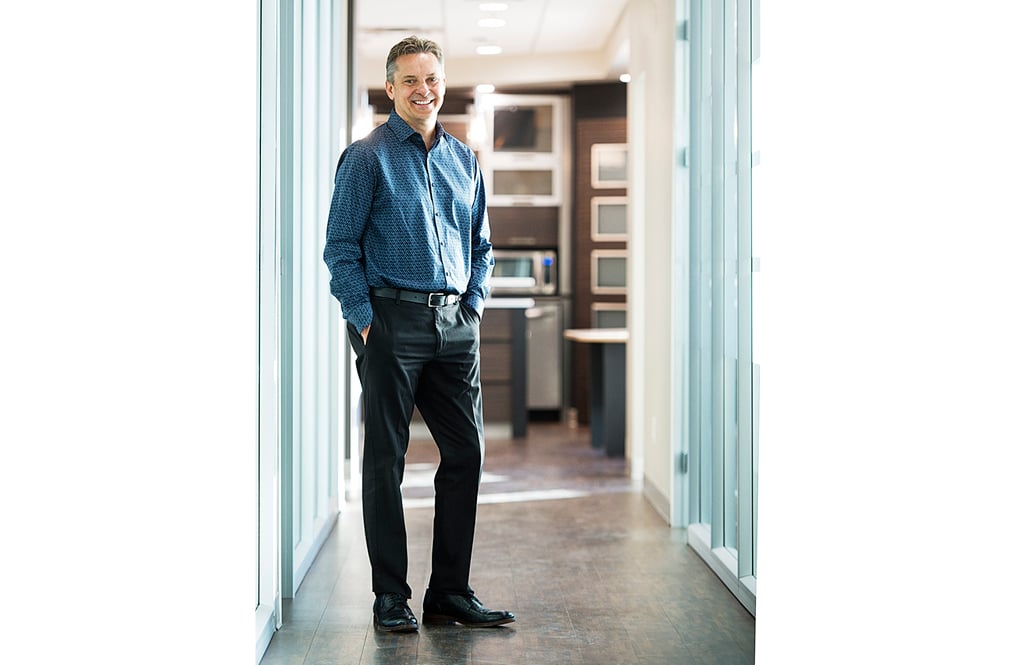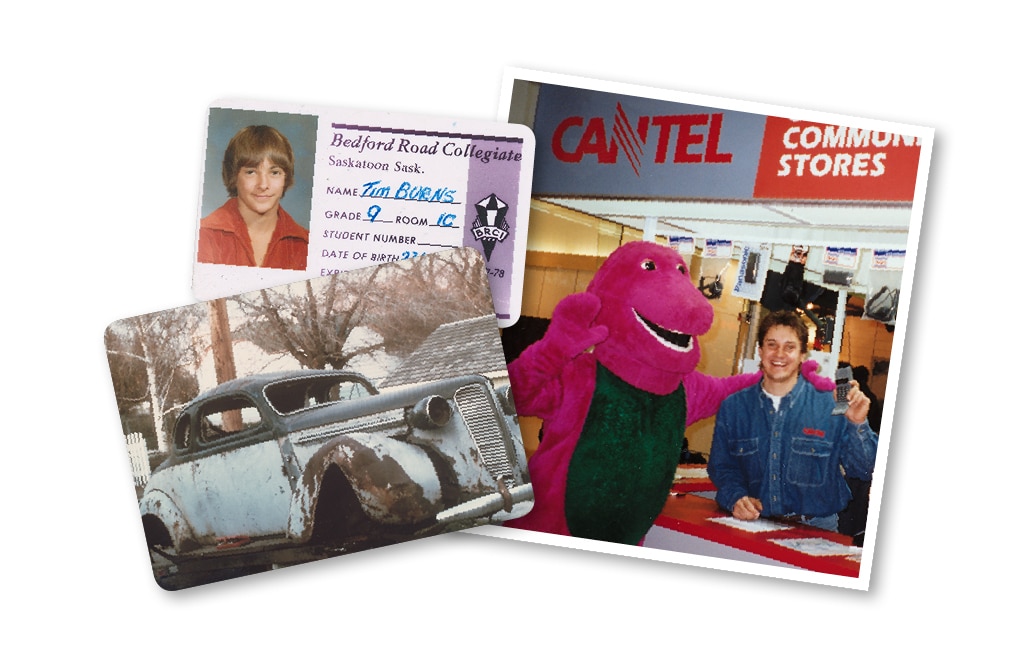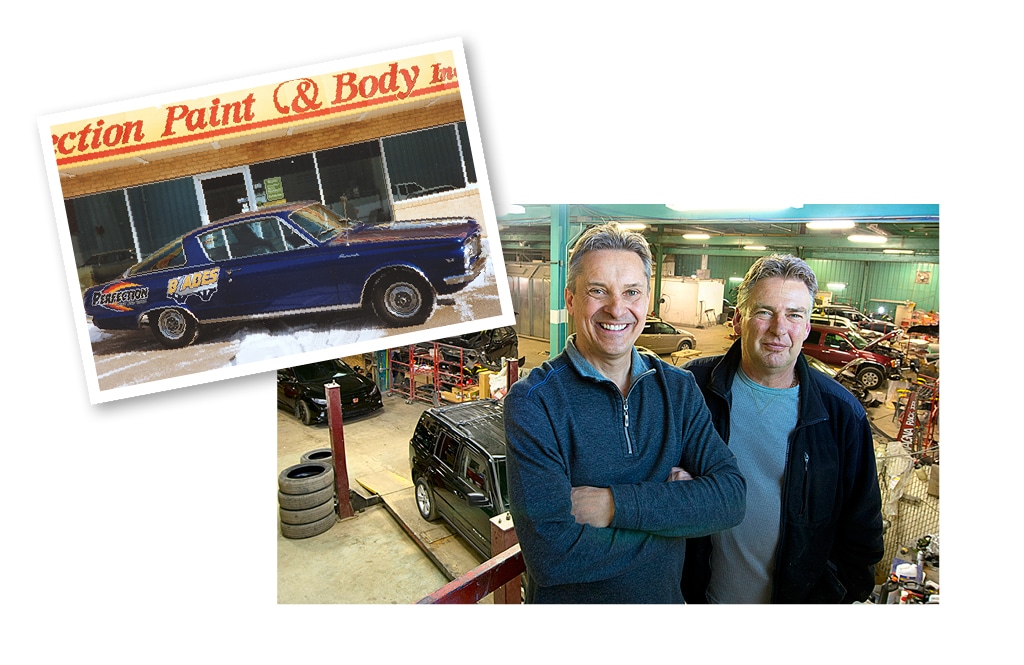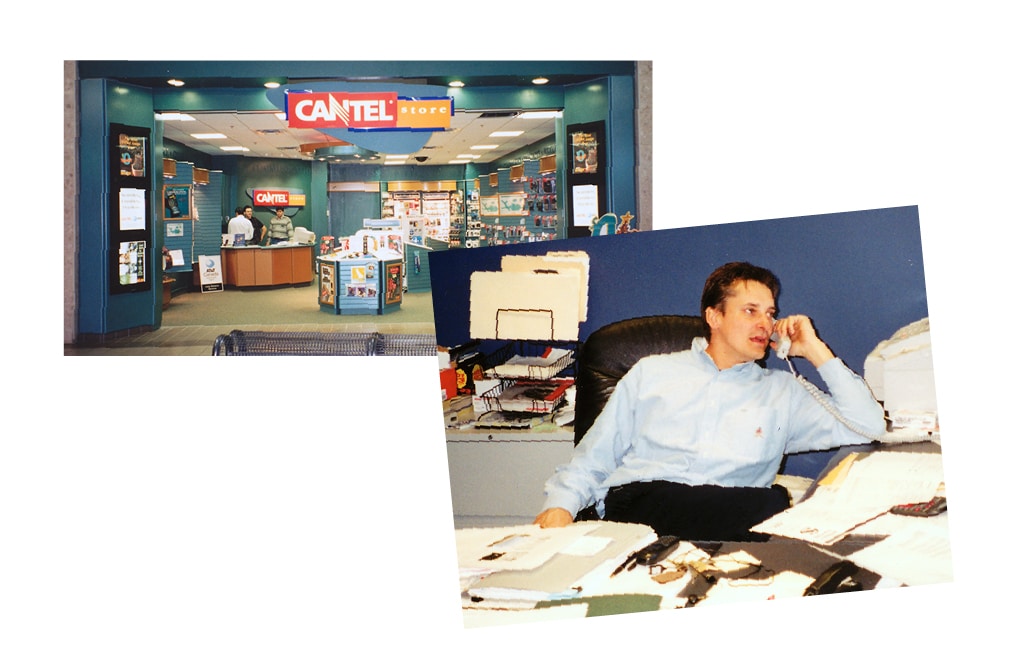“I thought the only way I would be able to control my destiny was if I made my own money, because then I knew I could make my own decisions.”
Tim Burns
You may have heard his name but can’t quite put a face to it. That’s because for more than 20 years, Tim Burns has never felt he had the time to devote to business groups. Most networking takes place after business hours, and he made a promise long ago: except for mandatory work obligations, evenings were for family. But recently, with his children growing up and mostly through university, Burns became a member of the NSBA for the first time
And although Burns admits networking is important, in the early years, he just had two things on his mind: growing his business and being present for his family. “I kept a low profile because I was busy, I didn’t have time for that stuff, and I wanted to spend time with my boys. I was coaching both of them, so that was sometimes five nights a week,” says Burns.
But dig a little deeper and you’ll find that when it comes to business Burns is anything but low profile. The 55-year-old owns 9 active businesses with 250-plus employees that span the retail, communication, construction, manufacturing, food service, oil and gas services, and the auto industry. He is also a property developer and his company Citylife Investment Corp. encompasses 40-plus retail and industrial properties across Western Canada.
Dig deeper still and it’s easy to see how it could have ended up quite differently. To understand Tim Burns’ story, we had to go back to 1964.
Serendipity
At the age of one, Burns was put into the foster care system. After being shuffled in and out of many foster homes, he was finally adopted at the age of seven by a loving family who would raise him as their own.
For the first time in his young life, he had stability, acceptance, and a true family. Burns admits those early foster care years were tough, and he credits his parents for giving him the strength and guidance that shaped the way he would carry himself through life.
“Up until that point, I had no control of my destiny” (referring to the number of times he was moved from home to home). “When I was a kid, I thought the only way I would be able to control my destiny was if I made my own money, because then I knew I could make my own decisions,” says Burns.

As a kid he bought hot rod magazines, dreaming of having one of his own someday. At 14, he saw an ad for a 1937 Dodge Coupe for sale in North Battleford and although the car was in bad shape, his dad borrowed a trailer and drove him there to pick it up. He spent the $75 of allowance he had saved to buy it. His dad was a city bus driver and could fix anything but had never restored cars. They worked side by side and figured it out together, but as time went on they realized it was going to cost more than they could afford to finish it.

They covered it up and moved it to the back yard, but not without Burns gaining an invaluable education in welding and mechanical work and a genuine love for restoring cars. His next project was a 1940 International pickup truck, in much better shape. By the time he was 16 and armed with a shiny new driver’s licence, the truck was restored and his dream of owning his own hot rod became a reality.
A year later, a friend whose dad owned a sweet black Dodge Dart Swinger took the car out one Friday night when his parents were cruise the city. Cutting a corner too sharply, his friend put a crease down the quarter panel. The friend was frantic, knowing his dad would lose his mind. Burns went with his friend to a local repair shop. The quote to fix it was $850 – money they didn’t have.
“I said, ‘I think I can fix it; I betcha I can fix it,’” Burns worked right through the weekend and painted it Sunday night.
“I could never have achieved what I have unless I had good people around me.” -Tim Burns
The friend’s dad arrived home Monday night. They waited, but a week passed without a word. Burns could not believe it – he had pulled it off. “And a light went on right then and there.” He had spent $50 for material and made an $850 repair. He realized he had a skill that could make him $800 in a day and a half. He had just found his ticket to freedom.
When he was 17 and still in high school at Bedford Road Collegiate, Burns put an ad in the classifieds: “Paint jobs as low as $500 – call Tim.” Soon his mom was taking messages from people wanting to get their cars painted and she wanted to know what was going on. Burns was attending school by day and doing estimates and repairing vehicles at night. He rented a three-car garage and employed a couple of friends to work for him, paying them $5 per hour. Burns spent every free minute working. His friends chirped him to come to parties but Burns was trying to keep up with demand and worked late into the evenings. He was even fixing his teachers’ cars.
Remarkably, his grades were still good enough to enroll in university in the fall of 1982, but it was soon evident that he could make more money working for himself. “You know that saying, ‘42 and a Malibu’? It means when you get out of school, they give you $42,000 and a car to drive. I was making more than that already, so why would I waste four years on school?” says Burns. He knew school was important but he could not focus knowing he was losing money every minute he wasn’t working and he made the decision to leave university.
In 1985, Burns took a chance and started an SGI-accredited collision repair business called Perfection Paint and Body.

Top: Perfection Paint and Body free courtesy car introduced in one of the marketing campaigns. Photo courtesy of Tim Burns.
Controlling Your Destiny
Max Berscheid says he and Burns met “by accident” – literally! After he had smashed up his vehicle and took it into Burns’ collision shop, they realized they had mutual friends and started hanging out together. Soon after, Berscheid started working at Perfection Paint and Body and for the past 30 years, the duo has worked together, eventually becoming business partners in Perfection Paint and Body. “We’ve grown up together,” Berscheid says. We went from a four-car repair shop to a 22,000 square foot facility and it’s been great. When it comes to business, Tim can be tough and aggressive. He doesn’t always tell you what you want to hear, he tells you what you need to hear and we’ve always been open, and I respect that. He is very smart and very innovative with ideas, and comes up with some off-the-wall things that work. Everything he touches grows and together we make a great team.”
Burns believed in advertising. He paid a jingle company from the US to create a catchy radio jingle and invested much of his profit in radio promotion. He introduced free courtesy cars and a lifetime warranty – two things never before advertised in Saskatoon. Competing collision repair shops were not happy but the campaign was effective.
In the early 1990s, a friend who worked for Cantel (now Rogers Wireless) had a proposal for him. Impressed by Burns’ marketing strategies, the friend wanted Burns to give his customers a free cellular car phone with every collision repair. At the time, practically no one had cellular phones – they were reserved for movie stars and millionaires. There would be no profit for Burns from the transaction but it wouldn’t cost him anything because Rogers would supply the phones. Burns agreed and began a steady marketing campaign that was a huge success.
By 1994, cellular phones were gaining popularity but still, only a small percentage of people had one. This intrigued Burns, who recognized an opportunity for a new business venture. He opened his first 500 square foot cellular store that year. Little did he know how big the cellular industry would become. Because its relationship with Burns was strong and he was successfully increasing the company’s brand profile in the province, Rogers soon offered him a deal to take over their corporate mall stores in Saskatchewan and Manitoba. Burns admits he was hesitant but he took the chance. His company Air Source was born. In the beginning, “Everyone was like, ‘What are you doing? You could shoot a cannon in there and not hit anybody. Why would you want a cellular store in a mall?’ And I said, ‘just wait, just wait.’ And I waited. Soon we were selling thousands of phones a month. You know, you just have to take a chance sometimes. Here’s something I’ve always lived by: if you do what you’ve done, you’ll get what you’ve got,” says Burns.
Burns eventually grew his cellular business to become one of the largest Rogers dealers in Canada. By 2010, the growth of the cellular industry had reached its peak. But during that time, Burns didn’t stand still and he continued taking chances on new opportunities in other industries, which along with the collision repair, communications, and property development also include asphalt paving, spray foam, printing, concrete, pizza, and industrial coating and blasting. Burns will be the first to say he wouldn’t consider himself an expert in all of the businesses he owns but he says at the end of the day it’s all the same – providing an exceptional product or service and a great purchasing experience. “You don’t need to know how to do that stuff, you just need to know how to find good people who do. I have to believe in them and they have to believe in me,” says Burns.
The Secret Sauce
Throughout his almost four-decade entrepreneurial career, Burns has made a lot of good choices by recognizing opportunities and taking risks but he believes that what defines the success of a business is hiring the right people.
“I could never have achieved what I have unless I had good people around me. Honestly, if you don’t have the people you don’t have anything. I know others have said that before but it’s so true. And you can’t just ‘get’ good people – you have to identify good people as time goes on.”
Having done both, Burns says it is quicker to purchase a well-run company than to build a new company from scratch because it takes years to build a brand. He believes in providing an opportunity to a key tenured employee by having them become an equity partner and purchase shares in the business over time through partnership dividends.

Bottom: Tim burn at his office during the early years. Photos courtesy of Tim Burns.
Top: First Cantel (now Rogers Wireless) cellular phone store in Saskatoon, 1994. Bottom: Tim burn at his office during the early years. Photos courtesy of Tim Burns.“Once I have identified and vetted the right person in that acquisition, I can then extend the opportunity to become a partner. So they are active managers of the company and they run it like it’s theirs because now it is. But sometimes they need someone to talk to. They may have run the day-to-day operations in the past, but never really knew the back end, such as the HR and financial side, because they were never privy to it. But now they are and need advice and direction, or sometimes I just need to inject cash. I’m always there to add stability.”
Burns also knows he’s not a micromanager, something he hopes empowers his business partners. He describes himself as a numbers guy who tries to spend more time with the businesses where the financial statements don’t look as good, rather than the ones where they do. And he recognizes that his relationships with his business partners are like a marriage: you need to listen and it takes work and patience.
“Communication is huge,” says Burns. “I have always had this philosophy that everything can be talked out. You can solve every problem if you have a mutual desire to solve it. You just have to be willing to sit and talk until it’s resolved.”
You Can Have It All…You Just Have To Wake Up Earlier.
Tim Burns has always loved being busy. Growing up, he never walked anywhere. He always ran. He admits he’s a workaholic, and he used to work late into the evenings. Once he had children, he knew this had to change. He made it part of his routine to get up as early as 3 am and head to work in the wee hours.
By the time he came home around 5 pm, he had already put in a 12- or 14-hour day but he could now spend quality time with his kids. Burns believes his structured routine not only helped him become a successful entrepreneur but also allowed him to be the dad he wanted to be.
“If you want to be successful, you need to work more, so get up earlier; that’s almost it. You are not going to do it all in eight hours a day – I mean, some people get lucky but you will never be highly successful. You’ve got to spend more time than that. But you don’t have to trade family for it, just start earlier,” says Burns.
Burns never traded family for business. In the past 20 years, he rarely missed a weekend with his sons or an opportunity to go to the lake with them. For years he coached them both in soccer and basketball and was a steady father figure both in the game and off the court.
As driven as he was as an entrepreneur, Burns always knew there needed to be balance in life, and as a dad, being a part of his sons’ lives was very important. “For me it’s not worth the trade – and you don’t have to trade. You can have both but you have to sacrifice. Believe me, I was tucking them in at 9 o’clock and falling asleep beside them because I was getting up so early.”

Tim’s wife, Rhonda Burns, describes Tim as a fun dad who is extremely dedicated to his family. She has worked with Tim in the businesses since they married in 1991. Through the ups and downs of business and family, one of the things that has always remained steady is Tim’s commitment to being there for his kids.
“His kids are everything to him. He never said no to spending time with them. He always wanted to be the coach because he always wanted to be the one teaching them,” says Rhonda. Rhonda shares her husband’s commitment to family and although they were both working, it was important to her that the family have supper together every night. But Rhonda admits there were moments in Tim’s career that made her nervous, especially when all the businesses were growing.
“I think before you have kids, it’s fairly easy, especially when you first get married. It’s fun and everything is exciting and your focus is on working and growing the business. And then you have kids and it’s lots and lots of work. But Tim was great. When the kids were born, he would come home from work and say, ‘OK honey, you’re done, I’m taking over,’ and he would do whatever had to be done with the kids and give me a break, and that was a real life saver,” says Rhonda.
As Burns reflects on his entrepreneurial career so far, he feels he has achieved both financial success and family success. He says one of the biggest things he has learned is that an entrepreneur has to lead, listen to, and reward employees fairly because they are the ones who enable you to have that work–life balance.
As for the future, Burns hopes his story is far from finished – he won’t be stopping anytime soon. As he puts it, “If you’re not growing, you’re dying.”
First published in the March 2019 edition of The Business Advisor.


